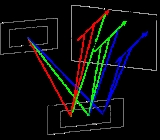
Echelle grating
Encyclopedia
An echelle grating is a type of diffraction grating
which is characterised by a relatively low groove density but is optimized for high diffraction orders. Echelle gratings are, like other types of diffraction grating, used in spectrometer
s and similar instruments, such as HARPS
, and numerous other astronomical instruments.
to scatter a majority of the light into the preferred direction of interest (specific diffraction order).
For multiple wavelengths the same is true; however, there it is possible that longer wavelengths of a higher order might overlap with the next order(s) of a shorter wavelength, which usually is an unwanted side effect.
In echelle gratings, however, this behaviour is deliberately used and the blaze is optimized for multiple overlapping higher orders. Since this overlap is not directly useful, a second, perpendicularly mounted dispersive element (grating
or prism
) is inserted as an "order separator" or "cross disperser" into the beam path. Hence the spectrum consists of stripes with different, but slightly overlapping, wavelength ranges that run across the imaging plane in an oblique pattern.
Exactly this behaviour helps to overcome imaging problems with broadband, high-resolution spectroscopic devices, like utilisation of extremely long, linear detection arrays or strong defocus or other aberrations
and makes the use of readily available 2D-detection arrays feasible, which reduces measurement times and improves efficiency.
Diffraction grating
In optics, a diffraction grating is an optical component with a periodic structure, which splits and diffracts light into several beams travelling in different directions. The directions of these beams depend on the spacing of the grating and the wavelength of the light so that the grating acts as...
which is characterised by a relatively low groove density but is optimized for high diffraction orders. Echelle gratings are, like other types of diffraction grating, used in spectrometer
Spectrometer
A spectrometer is an instrument used to measure properties of light over a specific portion of the electromagnetic spectrum, typically used in spectroscopic analysis to identify materials. The variable measured is most often the light's intensity but could also, for instance, be the polarization...
s and similar instruments, such as HARPS
High Accuracy Radial Velocity Planet Searcher
The High Accuracy Radial velocity Planet Searcher is a high-precision echelle spectrograph installed in 2002 on ESO's 3.6m telescope at La Silla Observatory in Chile. The first light was achieved in February 2003...
, and numerous other astronomical instruments.

Principle
As with other diffraction gratings, the echelle grating essentially consists of a number of slits with widths close to the wavelength of the diffracted light. Therefore light of a single wavelength in a standard grating at normal incidence is diffracted to the central zero order and successive higher orders at specific angles, defined by the grating density/wavelength ratio and the selected order. The angular spacing between higher orders monotonically decreases and higher orders can get very close to each other, while lower ones are well separated. The intensity of the diffraction pattern can be altered by tilting the grating. Especially with reflective gratings (where the holes are replaced by a highly reflective surface), the reflective portion can be tilted (blazed)Blazed grating
A blazed grating is a special type of diffraction grating.Blazed gratings produce maximum efficiency at a specified wavelength; that is, a diffraction grating that is "blazed at 250nm" will operate most efficiently when light with a wavelength of 250 nm passes through the grating.Like standard...
to scatter a majority of the light into the preferred direction of interest (specific diffraction order).
For multiple wavelengths the same is true; however, there it is possible that longer wavelengths of a higher order might overlap with the next order(s) of a shorter wavelength, which usually is an unwanted side effect.
In echelle gratings, however, this behaviour is deliberately used and the blaze is optimized for multiple overlapping higher orders. Since this overlap is not directly useful, a second, perpendicularly mounted dispersive element (grating
Grating
A grating is any regularly spaced collection of essentially identical, parallel, elongated elements. Gratings usually consist of a single set of elongated elements, but can consist of two sets, in which case the second set is usually perpendicular to the first...
or prism
Prism (optics)
In optics, a prism is a transparent optical element with flat, polished surfaces that refract light. The exact angles between the surfaces depend on the application. The traditional geometrical shape is that of a triangular prism with a triangular base and rectangular sides, and in colloquial use...
) is inserted as an "order separator" or "cross disperser" into the beam path. Hence the spectrum consists of stripes with different, but slightly overlapping, wavelength ranges that run across the imaging plane in an oblique pattern.
Exactly this behaviour helps to overcome imaging problems with broadband, high-resolution spectroscopic devices, like utilisation of extremely long, linear detection arrays or strong defocus or other aberrations
Aberration in optical systems
Aberrations are departures of the performance of an optical system from the predictions of paraxial optics. Aberration leads to blurring of the image produced by an image-forming optical system. It occurs when light from one point of an object after transmission through the system does not converge...
and makes the use of readily available 2D-detection arrays feasible, which reduces measurement times and improves efficiency.

